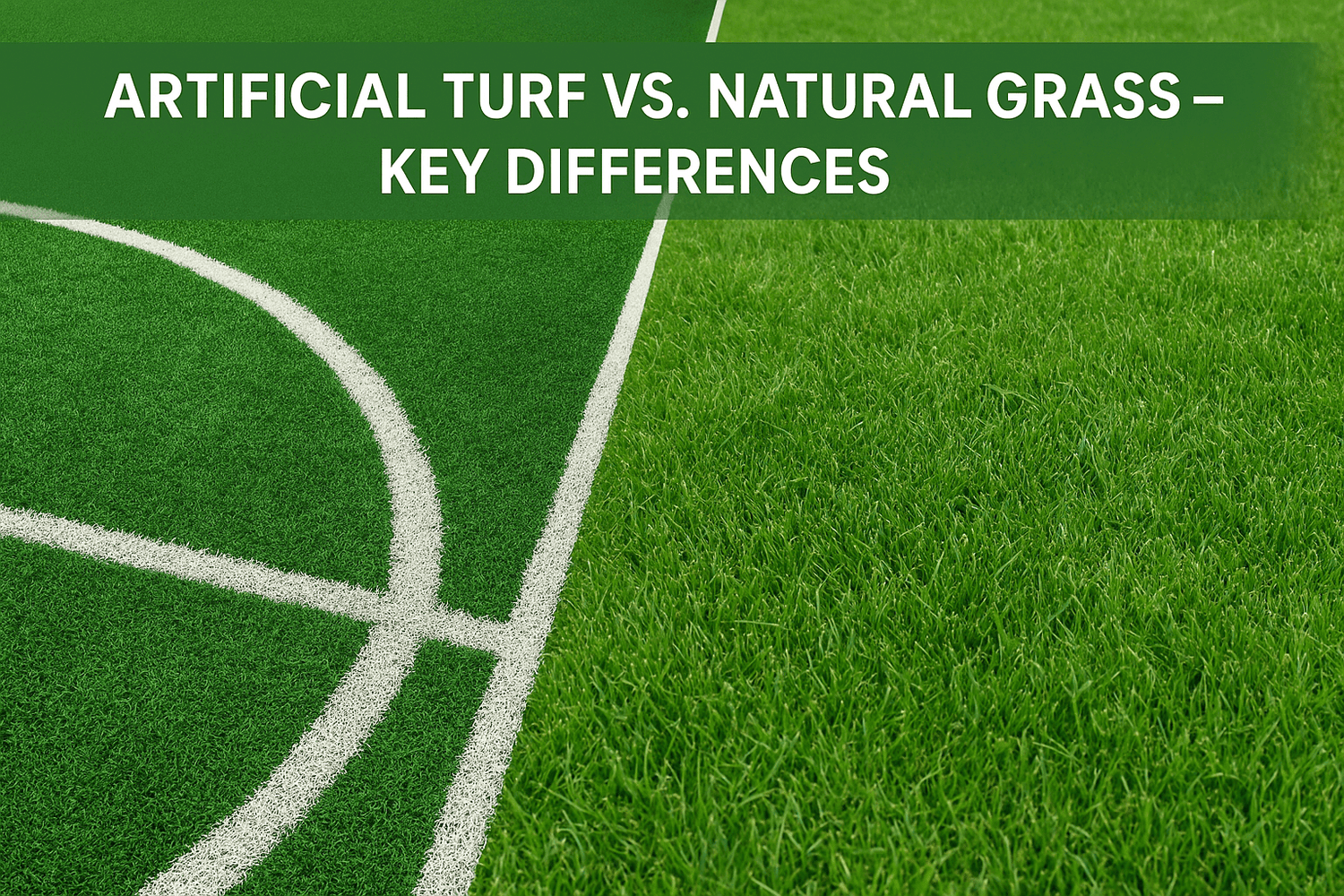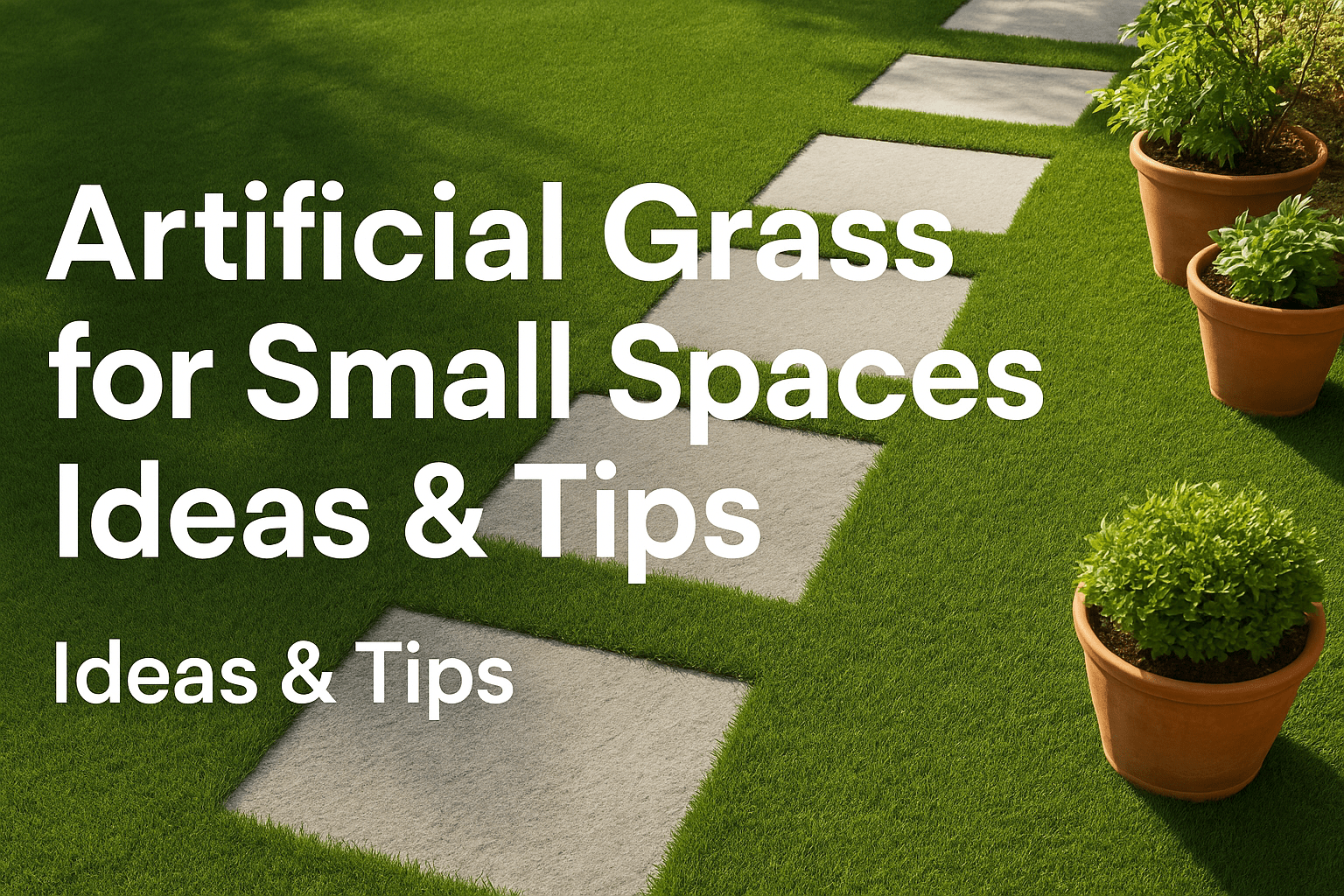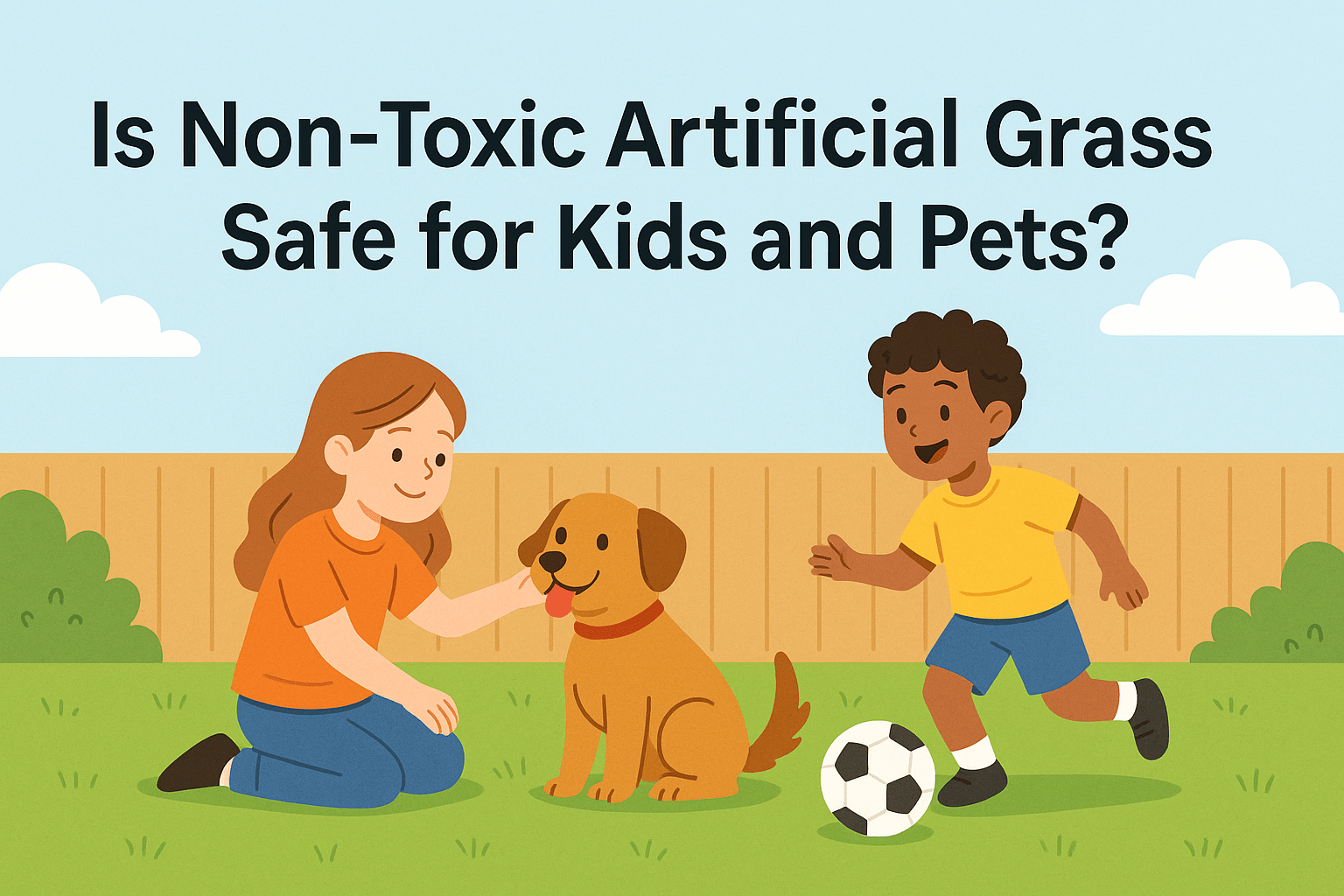Artificial turf is now used more than ever on sports fields. From schools to professional stadiums, many places are switching from natural grass to synthetic grass.
One big reason is that it’s easier to take care of and stays green all year long. You don’t need to mow it, water it, or worry about mud when it rains. That’s why artificial turf for sports is becoming the go-to solution for schools, parks, and stadiums.
This kind of turf works well in all weather and stays smooth, so players can run and play safely. Whether you’re planning a football field or a backyard sports area, knowing what to look for in turf is important.
This article will help you understand what makes good artificial turf for sports and what to think about before you buy.
Artificial Turf vs. Natural Grass – Key Differences
Artificial turf for sports costs more to install at the start, but it saves money over time. Once it’s in place, you don’t need to spend money on mowing, watering, or fertilising like you would with natural grass. You also don’t have to worry about using lawn tools, hiring workers, or wasting water.
Sports turf can be used more often than natural grass. It doesn’t wear out as quickly, even if teams play on it every day. Natural grass can turn muddy or patchy after heavy use, but artificial turf stays even and firm.
Natural grass uses a lot of water to stay green. In hot or dry areas, that’s a problem. Artificial turf helps save water and works well in all climates. Many modern turf products are made from recycled materials, which makes them a greener option. Some even include UV inhibitors to stop the turf from fading in direct sunlight.

Types of Artificial Turf for Sports Applications
Nylon Turf
Choosing the right artificial turf for sports depends on the sport, intensity, and field size. Nylon turf is very strong and built to handle rough use. It works best in areas where players run and cut a lot, like on football lines or goal zones. Even though it’s a bit stiff, it can last for many years without damage.
Polyethylene Turf
This turf feels softer than nylon. It is often used for football and soccer fields because it gives a nice balance of comfort and strength. It also looks more like natural grass, which is great if you want a real-looking surface.
Polypropylene Turf
Polypropylene is the least expensive type of artificial turf. It doesn’t last as long as the others, so it’s best for places where there’s less running or contact, like backyard putting greens or indoor training areas.
Must-Have Features for Sports Field Turf
Pile Height
Pile height means how tall the turf blades are. For sports fields, a short pile—about one to one and a half inches is the best. It helps the surface stay even and safe, even with lots of players running and moving on it.
Density & Stitch Rate
When turf has more blades close together, it’s called dense turf. This helps the field feel stronger and smoother. A dense turf also helps the ball bounce and roll the right way. Just like with bed sheets, more stitches usually mean better quality. A dense, high-stitch artificial turf for sports improves ball control and reduces trip risk.
Infill Options
Infill is the stuff that goes between the turf blades. It can be made of silica sand, crumb rubber, or natural materials. Infill keeps the blades standing up and helps the turf feel soft under your feet. It also adds grip, helps balls roll smoothly, and makes the surface safer for players.
Shock Pad Layer
Under the turf, there’s sometimes a soft layer called a shock pad. This adds extra cushioning to protect players when they fall or slide. It’s especially useful on playgrounds, doggy daycares, or fields that host many types of sports. If you want extra safety, this layer is a smart add-on.
UV and Heat Resistance
Turf can get hot in the sun, especially during summer. Some turf comes with cooling infill or UV blockers that keep the surface cooler. These features also help the turf last longer by protecting it from direct sunlight.

Drainage and Sub-Base Considerations
A good turf field needs to drain water quickly. If water stays on the surface, it can make the field slippery or even damage the turf. A stable base is critical to support artificial turf for sports, especially on heavily used fields.
There are two main drainage types: one is fully permeable backing, which lets water pass through everywhere. The other is called hole-punched backing, which has small drainage holes every few inches. For areas with heavy rain or flooding, fully permeable backing works best.
You should never place turf straight onto soil. Instead, use a sub-base made from crushed stone, gravel, or decomposed granite. This creates a strong, flat base under the turf. A solid sub-base helps stop water from collecting and makes the turf feel even and safe. You can also use a weed barrier or weed fabric underneath to keep weeds from growing through the turf.
Sport-Specific Turf Requirements
Football and soccer fields need artificial turf for sports that can handle heavy action. Players run fast, make sharp turns, and wear cleats, so the turf must be tough. Strong infill helps with grip and safety, while shock pads give extra cushioning to prevent injuries.
For baseball and softball, the turf must act a bit like dirt. Balls should bounce naturally, and players need to slide without getting hurt. The surface should be firm but not too hard. It should also stay even so the ball doesn’t take random bounces.
These sports need a flat, smooth surface. The ball should glide without bouncing too much. Many leagues have rules about how turf should perform, so it’s important to choose a product that meets federation standards.
Some fields are used for more than one sport. In these cases, it’s best to use balanced turf that supports different types of play. Modular line markings or colour-coded zones help keep things organised.

Safety and Performance Standards
Governing Bodies and Certifications
Many sports have official rules for turf. Groups like FIFA, World Rugby, and ASTM test turf for things like bounce, shock absorption, and safety. If turf passes these tests, it earns certifications like FIFA Quality Pro or Regulation 22. Choosing certified turf helps you know it’s safe and ready for play.
Turf Burn & Injury Risk
Turf burn happens when skin rubs against rough turf. To reduce this, pick turf with soft-touch fibres and cooling features. Proper infill, like crumb rubber or sand, also helps prevent injuries by softening the surface and stopping heat build-up.
Installation and Maintenance Tips
Installing turf for a sports field is a big job. It needs special tools, a strong base, and perfect alignment. That’s why you should always hire certified turf installers. They know how to do the job right, so the turf lasts longer and performs better.
Even though artificial turf needs less care than natural grass, you still need to look after it. Brush it regularly to keep the blades upright. Remove leaves, dirt, and trash. Check the infill and top it up if needed. Some fields also need cleaning to keep them safe and fresh. Proper installation is essential to ensure artificial turf for sports performs well under pressure.
Why Climate and Location Are Important
If your field gets lots of direct sunlight, the turf can become very hot. This can make it uncomfortable for players. In these places, it’s best to use turf with cooling infill or UV blockers. These features help lower the surface temperature and keep the turf looking fresh and green for longer.
In places that get heavy rain, drainage is key. Without it, water can sit on the surface and cause problems. Turf with fully permeable backing or good drainage holes works best. These let water pass through quickly, so the field stays safe and ready for games.
Cold weather can make turf freeze or shift if the base is weak. That’s why frozen areas need a strong sub-base. It helps keep the turf in place and working well even in snow or ice. Pick turf that stays flexible in freezing temperatures so it doesn’t crack or wear out. Artificial turf for sports should be selected based on how it handles your local weather patterns.
If your sports field is close to trees, you’ll need to clean it often. Leaves, twigs, and other debris can build up and block drainage. It’s also smart to use a weed barrier or weed fabric under the turf. This stops weeds from growing through and keeps the field looking neat.

Common Buyer Mistakes to Avoid
Some buyers pick turf based on looks only. But for sports, performance matters more. One big mistake is ignoring drainage. Without good drainage or permeable backing, water will collect and cause problems. Another mistake is choosing cheap turf without enough infill or shock pads, which can lead to injuries.
Some people forget to check if the installer is trained. Poor installation can ruin even the best turf. Others don’t ask about warranties or how long the turf will last. Make sure you ask questions, get details, and work with trusted companies.
Quick Comparison Guide for Choosing Sports Turf
|
Section |
Key Consideration |
Performance Impact |
Maintenance Needs |
Cost Consideration |
Best Practice Tip |
|
Artificial Turf vs. Natural Grass |
Cost, durability, water savings |
More play time, fewer cancellations |
Low after installation |
High upfront, low long-term cost |
Focus on total cost over time |
|
Types of Turf |
Nylon, Polyethylene, Polypropylene |
Different durability and comfort levels |
Varies by type and usage |
Nylon most expensive, Polypropylene cheapest |
Match turf type to sport and use |
|
Must-Have Features |
Pile height, density, infill, shock pads |
Affects safety, ball movement, player feel |
Needs brushing and infill top-up |
Adds to cost but boosts lifespan |
Invest in features that match needs |
|
Drainage & Sub-Base |
Drainage systems, sub-base materials |
Prevents water pooling and surface damage |
Depends on drainage setup |
Proper base increases initial cost |
Use permeable backing in rainy areas |
|
Sport-Specific Needs |
Football, baseball, hockey, multi-sport |
Ensures fair play and reduces injuries |
Depends on sport intensity |
Custom turf adds cost |
Follow federation guidelines |
|
Climate & Location |
Sun, rain, cold, debris, weed control |
Helps turf last longer and stay safe |
More cleaning near trees, snow areas |
Needs site-specific planning |
Choose turf based on local weather |
Costs, Financing & ROI
Buying artificial turf includes more than just the surface. You also pay for the base work, the type of turf, the infill, and the labour. The total cost can vary based on how big the field is (measured in square feet) and which features you choose.
Even though turf costs more at first, it saves money over time. You don’t need to mow, water, or re-seed it. Fields stay ready for use longer, which means more games, less down time, and higher revenue for sports facilities.
If the upfront cost feels high, many companies offer financing. This might include lease-to-own plans or special grants for sports facilities. These options help spread out the cost and make it easier to invest in quality turf.
How to Choose a Trusted Turf Supplier
Choosing the right supplier is just as important as picking the right turf. Look for companies with good reviews and experience in building sports fields.
When it comes to sports turf, LITA Grass is a trusted name known for durable, high-performance products. Their turf systems offer strong blade density, reliable UV protection, and custom options for football, soccer, baseball, and multi-use fields.
LITA also provides turf with shock pad compatibility and cooling technology, making it ideal for high-traffic fields in any climate. With a track record in sports facility installations, LITA Grass is a dependable choice for safe, long-lasting surfaces.
Conclusion
Picking the right artificial turf for sports takes planning. You need to think about what sport it’s for, how often it will be used, and what your budget allows. Don’t just look at the price—think about value, safety, and how long the turf will last.
A good turf setup will save you money in the long run and keep your field safe for everyone. For the best results, always work with skilled installers and trusted suppliers who know what they’re doing.
Looking for reliable turf that performs under pressure? Explore LITA Grass for quality sports field solutions backed by durability and expert support.



Leave a comment
This site is protected by hCaptcha and the hCaptcha Privacy Policy and Terms of Service apply.